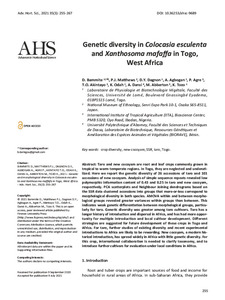| dc.contributor.author | Bammite, D. |
| dc.contributor.author | Matthews, P.J. |
| dc.contributor.author | Dagnon, Y.D. |
| dc.contributor.author | Agbogan, A. |
| dc.contributor.author | Agre, A.P. |
| dc.contributor.author | Akintayo, O.T. |
| dc.contributor.author | Odah, K. |
| dc.contributor.author | Dansi, A. |
| dc.contributor.author | Abberton, M. |
| dc.contributor.author | Tozo, K.S. |
| dc.date.accessioned | 2022-03-31T15:19:09Z |
| dc.date.available | 2022-03-31T15:19:09Z |
| dc.date.issued | 2021 |
| dc.identifier.citation | Bammite, D., Matthews, P.J., Dagnon, Y.D., Agbogan, A., Agre, P.A., Akintayo, O.T., ... & Tozo, K.S. (2021). Genetic diversity in Colocasia esculenta and Xanthosoma mafaffa in Togo, West Africa. Advances in Horticultural Science, 35(3), 255-267. |
| dc.identifier.issn | 1592-1573 |
| dc.identifier.uri | https://hdl.handle.net/20.500.12478/7399 |
| dc.description.abstract | Taro and new cocoyam are root and leaf crops commonly grown in tropical to warm temperate regions. In Togo, they are neglected and underutilized. Here we report the genetic diversity of 26 accessions of taro and 101 accessions of new cocoyam. Analysis of simple sequence repeats revealed low polymorphic information content of 0.43 and 0.25 in taro and new cocoyam, respectively. PCA scatterplots and Neighbour Joining dendrograms based on the SSR data clustered accessions into groups that moreorless correspond to morphological diversity in both species. AMOVA within and between morphological groups revealed greater variances within groups than between. This indicates weak genetic differentiation between morphological groups, particularly for taro. Genetic diversity was greater among taro cultivars. Taro has a longer history of introduction and dispersal in Africa, and has had more opportunity for multiple introduction and local cultivar development. Different strategies are suggested for future development of these crops in Togo and Africa. For taro, further studies of existing diversity and recent experimental introductions to Africa are likely to be rewarding. New cocoyam, a modern historical introduction, has spread widely in Africa with little genetic diversity. For this crop, international collaboration is needed to clarify taxonomy, and to introduce further cultivars for evaluation under local conditions in Africa. |
| dc.description.sponsorship | International Foundation for Science |
| dc.format.extent | 255-267 |
| dc.language.iso | en |
| dc.subject | Crops |
| dc.subject | Diversity |
| dc.subject | Genetic Diversity |
| dc.subject | Taro |
| dc.subject | Togo |
| dc.title | Genetic diversity in Colocasia esculenta and Xanthosoma mafaffa in Togo, West Africa |
| dc.type | Journal Article |
| cg.contributor.crp | Genebanks |
| cg.contributor.crp | Roots, Tubers and Bananas |
| cg.contributor.affiliation | Université de Lomé |
| cg.contributor.affiliation | National Museum of Ethnology, Japan |
| cg.contributor.affiliation | International Institute of Tropical Agriculture |
| cg.contributor.affiliation | Université Polytechnique d’Abomey |
| cg.coverage.region | Africa |
| cg.coverage.region | West Africa |
| cg.coverage.country | Togo |
| cg.coverage.hub | Headquarters and Western Africa Hub |
| cg.researchtheme | Biotech and Plant Breeding |
| cg.identifier.bibtexciteid | BAMMITE:2021 |
| cg.isijournal | ISI Journal |
| cg.authorship.types | CGIAR and developing country institute |
| cg.iitasubject | Agronomy |
| cg.iitasubject | Biodiversity |
| cg.iitasubject | Genetic Improvement |
| cg.iitasubject | Plant Breeding |
| cg.iitasubject | Plant Genetic Resources |
| cg.iitasubject | Plant Production |
| cg.journal | Advances in Horticultural Science |
| cg.notes | Open Access Journal; Published online: 09 Jul 2021 |
| cg.accessibilitystatus | Open Access |
| cg.reviewstatus | Peer Review |
| cg.usagerightslicense | Creative Commons Attribution 4.0 (CC BY 0.0) |
| cg.targetaudience | Scientists |
| cg.identifier.doi | https://dx.doi.org/10.36253/ahsc-9689 |
| cg.iitaauthor.identifier | Paterne AGRE: 0000-0003-1231-2530 |
| cg.iitaauthor.identifier | Michael Abberton: 0000-0003-2555-9591 |
| cg.futureupdate.required | No |
| cg.identifier.issue | 3 |
| cg.identifier.volume | 35 |

